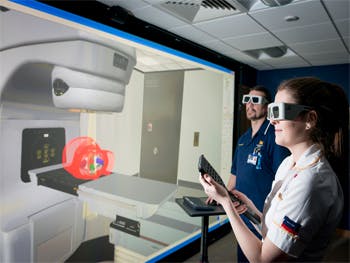Radiography placements
To give you an insight into what it's really like, watch the radiotherapy placement film which catches up with mentors, tutors as they guide a student through her placement, plus get the inside scoop from Lindsay.
Lindsay's story: A Radiotherapy student on placement
 A typical day on placement for a student radiotherapy radiographer can be long, emotional, exhausting, challenging and interesting, however, no two days are ever the same. Each day brings a new experience whether this is observing the treatment of cancer, observing a new technique, learning a new aspect of patient care or recognising when a patient requires medical attention.
A typical day on placement for a student radiotherapy radiographer can be long, emotional, exhausting, challenging and interesting, however, no two days are ever the same. Each day brings a new experience whether this is observing the treatment of cancer, observing a new technique, learning a new aspect of patient care or recognising when a patient requires medical attention.
Under the radiographer’s supervision students are involved in most aspects of a patient’s treatment including first day chats, setting up of patients and filling in treatment sheets. However, there are some limitations and it is important that as a student you are aware of these and do not go beyond them and always adhere to radiation safety procedures.
One of the most fundamental items for a student radiographer is a decent, comfortable pair of shoes as you will spend a lot of the time running in and out of a treatment room. The distance can equate to several miles over the course of a day and your shoes will become your best friend by the end of a placement block.
One of the most important skills you need as a student radiographer is the ability to communicate with both staff and patients. This may sound easy, however, some students feel it is the most challenging aspect of the role. One day you may be chatting to a patient whose prognosis is positive and another talking to a patient who has just been told their condition is palliative and they do not have long left to live. This can be an emotional time for both patients and their families and it is vital that you are able to empathise with their situation and offer support. This can be as simple as sitting and listening to them or making them a cup of tea.
As a student you will find yourself on placements that you feel may not be applicable to you or where you cannot participate, this may include chemotherapy, diagnostic imaging or oncology wards. It is important to approach each placement with an open mind and as an opportunity, as the chances are that you will never get the experience again. Always show an interest and find something that you can do, this may be as simple as chatting to a patient about their experience, it is amazing what information you can find out from them.
Then there are the naked bodies! The nature of radiotherapy means that you will see a lot of flesh and intimate anatomy and have to manoeuvre patients manually. At first, this may be embarrassing but it is important that the patient is made to feel as comfortable as possible and their dignity maintained at all times. It is also important to be aware that at times you may be exposed to vomiting, phlegm, urine and other bodily fluids so a strong stomach is sometimes required. While you might think working with cancer patients can be depressing and sad, this is not always the case and the radiotherapy department can be a happy, jovial place with plenty of tea, chocolate and biscuits.